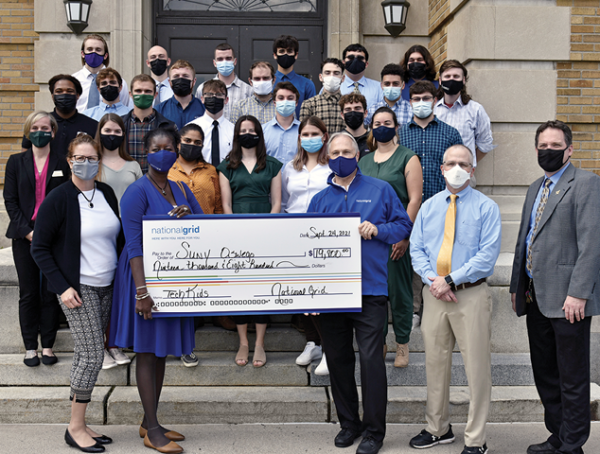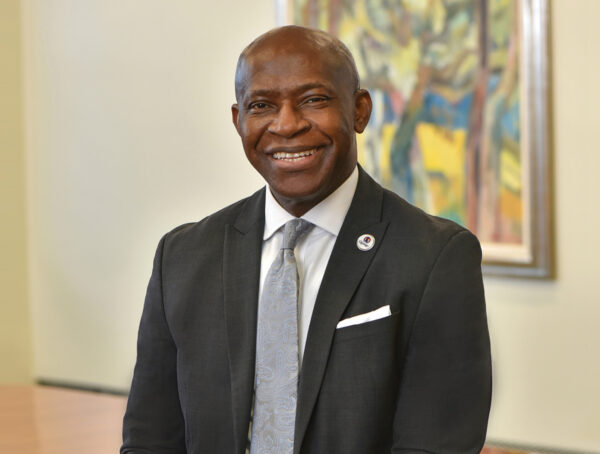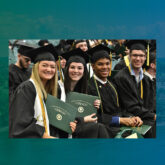If you are one of the 100 million Americans with smart phones, chances are you are holding the work of a fellow Oswego alumnus.
Peter Bocko ’75, chief technology officer for Corning Glass Technologies, a business within Corning Inc., driving new glass opportunities, has spent his career developing and bringing to market glass used in cutting-edge high-tech devices like these. His latest project is Corning Gorilla Glass, a super-tough, ultra-thin product used in some of the hottest electronic devices on the planet.
You can feel its cool touch as it protects your new high-tech phone from scratches and bumps. Soon you can hang it on your wall and marvel at its sleek beauty: At this January’s Consumer Electronics Show in Las Vegas, SONY announced that it would be using the durable material in select models of its Bravia line of LCD televisions.
Other fruits of Bocko’s labor are less obvious. He and the display technology team are developing a flexible glass that will someday be used in the design of new e-readers and other emerging technologies. It provides advantages over current materials, and will help make e-books easier and more fun to read. And an earlier product of theirs — an environmentally friendly LCD glass with no added heavy metals — was especially important to one of Bocko’s Japanese clients, whose factory sits alongside a river.
Much of the Corning team’s work has been to produce thinner glass, and that, too, saves the environment. “You melt glass by the pound, sell it by the square foot,” Bocko explains. A 19-inch traditional TV — where the picture comes from a cathode ray tube or CRT display — uses 40 pounds of glass. A modern LCD set uses much less, in a sheet only 0.7 mm thick.
Bocko is passionate about glass. After 32 years at the world’s leader in specialty glass and ceramics and 22 years helping to make them a key player in LCD technology, this self-proclaimed “glass guy” can still get rhapsodic about the virtues of Corning’s newest achievement and the possibilities for the future.
Dressed in a sport jacket rather than a traditional lab coat, Bocko walks — and talks — fast. Leading a visitor through the maze of Corning’s research facility at Sullivan Park, his staccato delivery of facts, figures and anecdotes is dizzying. His mind is moving at a million miles a minute, too — always looking ahead to the next big thing.
That’s a habit rooted in the Corning way of doing business, he admits. “We work with key customers to give more value so they can’t do without us,” he says. “When they have product A, we are working on product B, proactively obsoleting our own product.”
People are key
In an irony not lost on the thoughtful scientist, Bocko says he was hired with the profits Corning earned from TV’s cathode ray tubes, then spent most of his career making CRT sets obsolete in favor of more efficient, environment-friendly and beautiful LCD TVs.
But if product is important to Bocko, people are more so. Relationships are valuable to him, and that is key to his success in the Asian market. “When you say something you have to mean it,” he says. “In Asia, you cannot treat business relationships casually.”
 Case in point: His interview with Oswego magazine was postponed by a week, because he had to interrupt his Christmas vacation to make a last minute trip back to Japan. There was news that Bocko could not let a key customer hear from anyone else.
Case in point: His interview with Oswego magazine was postponed by a week, because he had to interrupt his Christmas vacation to make a last minute trip back to Japan. There was news that Bocko could not let a key customer hear from anyone else.
“They knew I flew 12,000 miles to be there for one two-hour meeting,” he says. But that courtesy showed them that he really valued their relationship. “They know they can trust me.”
Corning’s business is built “on the basis of relationship and trust — we give more value,” he will tell you. For 20 years he has worked almost exclusively with the LCD end of the business, helping corporate customers and their designers find uses for Corning’s products. “Orienting R&D not on what you think is a good idea but collaborating with the customer,” Bocko explains.
In his role as chief technology officer for Corning Glass Technologies, the relationships have to run in both directions. While he is working with customers to help design new uses for Corning technology, he also must interface with a team back in New York state’s Southern Tier to make the magic happen. That’s a juggling act that comes naturally for Bocko, since he led the team stateside — as a scientist himself — before his transition to Asia in 2007.
People skills are something he learned along with good science in Oswego, working with mentors like Distinguished Teaching Professors Emeriti Augustine Silveira and Ken Hyde. He admits to picking up style cues from Silveira, who had a unique classroom technique.
“The way he managed the classroom — he would value participation,” Bocko says. “He could make people feel he was really interested in them and valued their ideas.”
The Waterville native chose Oswego for its excellent reputation, especially in chemistry, and the opportunity to work one-on-one with scientists. He valued the personal attention he received at Oswego and how that translated into real-life lessons.
In working with Hyde, Bocko learned the value of good, hard, incremental work. “Chip away and there was insight,” is the message he took away from days — and nights — in the lab in Snygg Hall. “Science is not a matter of pure inspiration, just good, dogged work and inspiration will come.”
MORE: Your next TV
Those hours of hard work provided some laughs, though. Bocko fondly remembers the time he set his hand on fire. He was working with a flask that included ether. He held it over the flame from a Bunsen burner and it exploded, setting his hand on fire. He shook it like a match, and because the ether was so volatile, it went out almost immediately. But the laughs lingered to this day.
Then there was the time he burned his pants off. Bocko was doing some work for Hyde at 7 a.m. and dropped a half-gallon of sulphuric acid on his jeans. “Not a promising start,” he laughs. When Hyde came into the office, there was Bocko sitting in a lab coat, bare legs sticking out, waiting for his roommate to show up with spare jeans. “Pete burned off his pants,” said his lab partner. “Professor Hyde just shook his head,” remembers Bocko with a chuckle.
 None of that deterred his ambition to obtain a Ph.D. and “do science that really mattered.” Bocko knew from his high school years that he wanted to be a research chemist, practicing science at a level that mattered: Not doing chores for others, but setting policy and direction.
None of that deterred his ambition to obtain a Ph.D. and “do science that really mattered.” Bocko knew from his high school years that he wanted to be a research chemist, practicing science at a level that mattered: Not doing chores for others, but setting policy and direction.
Oswego played an important role in fulfilling that goal. The research he did — and the scientific articles he published with his Oswego professors — helped him gain admission to a prestigious doctoral program at Cornell University.
Oswego played another important role in his life — it’s where he met his wife of 35 years, Andrea Guglielmo Bocko ’73, M ’75.
They were both working at an Oswego chemistry lab one summer, Pete on copper complexes and Andrea on cobalt complexes with pyridine, which Pete calls “one of the most foul substances known to man. It smells like a sneaker worn by Bigfoot,” he says with a laugh. Andrea brought her pyridine into the lab and, well, Pete couldn’t help but notice her.
“I always liked smart girls — a girl in a lab coat,” he says, with a grin. So when he met Andrea, he made up his mind after the first date. “I’m going to marry this girl,” he told his brother.
MORE: Extraordinary Expat: Andrea Bocko ’73, M ’75 shares love of science overseas
“He said, ‘Slow it down,’” Pete remembers. “But he had it wrong.”
How Bocko became Corning’s chief technology officer in Asia has its own story.
“People underestimate the amount of resolve it takes to develop a new product,” he says. He joined Corning in 1979 as a glass researcher, and became part of an exploratory LCD team in 1982. In 1988, he became full-time head of product development for LCD development, but through budget cuts he lost his team because Corning was not sure of the market potential.
“So I spent time traveling, making relationships with the companies that would use the glass, [people in] Japan, Korea, Taiwan and, now, China.”
Put simply, he says, “We make the glass, the customer makes the LCD: We want to enable them to make their product the best it can be and as economically as possible.”
So he has spent the better part of two decades traveling back and forth between Corning and Asia, and now makes his full-time home in Tokyo, traveling back to Corning for meetings at least a dozen times a year.
Each flight is about 7,000 miles and takes 15 hours. “I’ve spent six months of my life in a 747,” he quips.
Whether up in the air or in the lab, Bocko is thinking fast, working hard and bringing new products to market that will improve peoples’ lives everywhere.
You might also like
More from Featured Content
Vision for the Future
VISION for the Future Peter O. Nwosu began his tenure as the 11th president of SUNY Oswego, building on the solid …
Envisioning the Potential in All Students
ENVISIONING the Potential in All Students Educator donates $2 million in recognition of his Oswego education, in support of future teachers Frank …
A Vision of Support
A VISION of Support Award-winning principal makes an impact on her school through her positivity and commitment When Nicole Knapp Ey ’02 …













